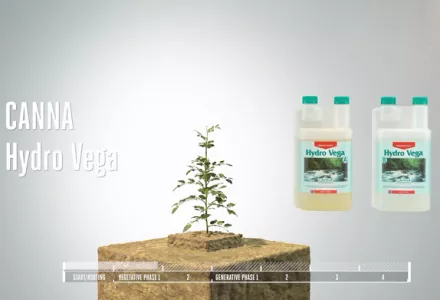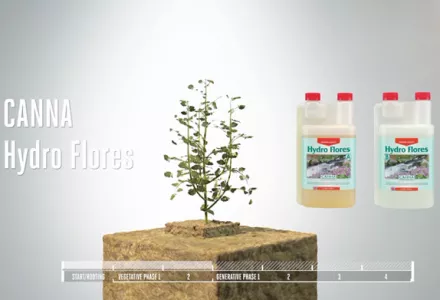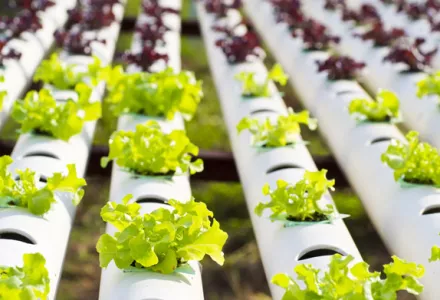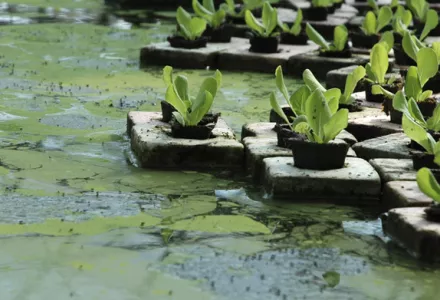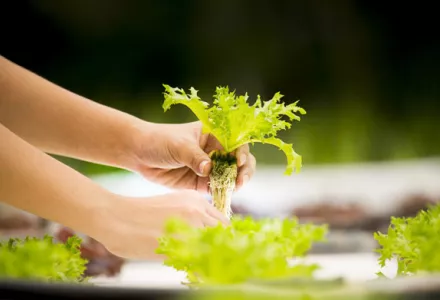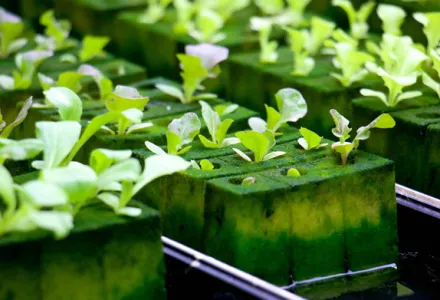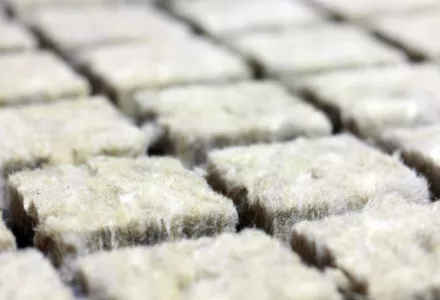Run-to-Waste (RTW) is a simple concept when applied to horticulture that means exactly what it says; irrigation applied until it moves out of the root zone and is disposed of. It can also be called normal, or natural, since in the outdoors, water moves through the soil profile. It is the only natural system for those plants that evolved under these conditions.
The definition requires that water moves into a root system then flow out of the root system, usually on saturation. Crops in the fields are watered from above and the water moves into and through the root zone, and then exits the root zone once the root zone is saturated. It works the same in potting mix and containers watered from above. It can also be argued to include aquatic plants grown in moving waters such as streams, rivers and shore lines.

Run-To-Waste is an irrigation system or style of watering, nothing else, but meaning more. It also implies that nutritive elements are delivered to the plant in the water flow and picked up by the root system, deposited in the root system, or passes through the root system.
Mass Flow
Even where dry fertilizer is used in the mix, the water would dissolve it and deliver it to the next step: a process known as Mass Flow. It applies because in reality the system is named after the way water (irrigation) is applied to a root system and dealt with afterwards. It flows through the medium (peat, rock wool, clay, even air), delivers its load of nutrients while collecting the excess and passes out of the system to never return.
Even if no nutrients are put in the water, unless the water is pure, whatever is in it will stay behind the same as the nutrients might have. The other system is recirculating where the drainage from the root zone is collected and sent back into a storage tank for re-application.
This is all there is to it, simple and effective, but as a growing concept it usually means much more.

Understanding of irrigation and fertigation
Irrigation is the provision of water to a crop. There are many ways to do this such as by hand, through an automatic system, or by natural rainfall. Which method is used depends on needs and budget, as automatic systems can be expensive and allowing nature to do the watering is a big risk. All of this, however, amounts to the same thing, delivering water to the root system.
Fertigation is the application of fertility or nutrients in the irrigation water. This is an easy and cost effective way of accurately applying fertilizer to the crop. It combines both watering and fertilizer applications and is done on the normal schedule. There are two methods that can be used here: one is intermittent feeding and the other is constant feeding.
Intermittent feeding is where fertilizer is applied through the irrigation system once then only water is applied for a specific number of times after. This method can only be used in systems where there is the ability for elements to be stored and gradually released back to the medium’s soil solution (water present in the medium); thus an affecting medium. An affecting medium is a medium with a buffering ability (it binds nutrients and releases them). This method leaves a longer period of time where the levels of available nutrients in the medium are gradually used up. The concentration of nutrients applied has to be stronger than optimal levels to get through the period of time where no additional nutrients are applied. A period of time exists where the level of nutrients is less than optimal.
Constant feeding is where fertility is applied with every watering cycle. This method can be used on any system and any medium. Concentrations applied are done at lower levels than intermittent applications and the amount of time medium fertility levels are below optimal is greatly reduced. Plant growth is less affected by decreased availability of optimal levels of nutrients.
All plants are grown as a Run-to-Waste system or recirculating system
There is no other way to do it short of beaming the water and nutrients into the plant directly. There are hybrid systems out there that have a hard time falling into one or the other but, in the end they are hybrids of the same two systems. These hybrids include Ebb and Flow (Flood and Drain), Aeroponics (air based), and Aquaponics (deep water culture). Air Based would be recirculating if the run off where re-pumped to the plant or RTW if not. Deep Water would tend to be recirculated depending on the size and type of the system and the number of plants in it. Flood and Drain is more of a Run-But-No-Waste system as the water moves up into the column of medium carrying its nutrient load and excess salts left over to the top of the column then leaves it there while it drains back down into the tank to be applied again and partially redistributing the salts as it retreats.

Run-To-Waste is the most used system in cultivation and nature. There are two basic means of growing plants, the first is in a soil or soil-less organic medium, the other is hydroponically. Just because the fertility is applied in a liquid solution does not make it hydroponic. Growing hydroponically requires that the fertility is supplied in a water solution either directly in the solution itself or in an inert medium such as clay, gravel, perlite, sand, mineral wool, or other materials that exhibit no effect on the nutrients or the plants. Inside of the hydroponic method of growing, the system can be either recirculating or run-to-waste. Where the plants are in an organic soil substitute or mineral soil, it can no longer be considered hydroponic.
Mediums that are capable of acting on the solution or plants, such as mineral soil or soil-less growth mediums, have multiple layers of influence where hydroponic only has one, the solution. These mediums will affect different aspects of what the plant ‘sees’, including pH changes, nutrient storage and release, water retention, and plant support.
These variables can be difficult to predict, change, or mediate because even the smallest thing can affect them such as temperature, irrigation frequency, time, and a host of other variables.
Controlling hydroponics
Hydroponics depends on exact control to achieve its results where variables like solution temperature, selective uptake of particular elements, and others have to be monitored for optimal results. In an affecting medium, these things are controlled (buffered)more by the medium including pH buffering, slower temperature deviations, porosity for air and moisture control, and a continuous supply of nutrients.
A big influence is on the structure of the root itself with hydroponic roots developing differently than medium based roots. Even though both roots may grow in a medium, inert mediums do not, by definition affect anything and show the roots only the solution. Plant roots that develop in mineral (soil) mediums or organic substitutes (soil-less) generally tend to allow greater uptake of water and nutrients where inert medium based roots develop the ability to restrict this uptake.
In the end, research has repeatedly shown that there is no appreciable increase in the size or quality of yields in hydroponics over growing in an affecting medium, it just serves different needs. Hydroponics is for specific situations where growing in typical systems is difficult, the grower has a good deal of knowledge on application of the principles, and has a great deal of time or the specialized equipment to monitor the system.

considered hydroponic.
Both systems use the principle of Mass Flow to provide a nutrient load. In order for an available nutritive element to be taken up by a plant, it has to be suspended in liquid; water. When an element is released from the natural breakdown or given off a Cation Exchange Site, it does so into a fluid matrix and becomes available to the plant in solution.
In a hydroponic system, they are only supplied and available in solution. In an affecting medium such as mineral soil or a soil-less peat mix, it moves into the soil solution in response to concentration equilibrium where an equal amount moves onto the medium particle as remains in solution, or vice versa.
As this solution moves to the root surface, in either system, it becomes available to the plant, a concept known as Mass Flow.
With any method, the principle remains the same: nutrients have to be in solution to be taken up. They have to be in the correct amounts in relation to themselves as individual elements and to the needs of the plant. They also have to be in the correct form (ion) which is why pH is so important.
Which is the best system for growing; recirculating or Run-To-Waste?
There really is no right or wrong answer here; it is more a matter of convenience. Run-To-Waste systems require much less effort but do generate a disposal problem.
In any system, plants work with ratios of all the nutrients to themselves. If one nutrient, even a trace element like Molybdenum, is less than the plant needs, it becomes the limiting element and all the remaining elements are in excess and will cause accumulation issues within the plant because they cannot be used. The plant will also develop slower because, while the amount of fertilizer may be at optimal levels overall, the limiter reduces what the plant can use and enters a deprived state. This results in a deficiency usually seen in the plant overall, but not always if it is a part of a process. (Chlorine, a critical component in the splitting of a water molecule for photosynthesis will show in an overall reduced energy state of the plant showing slower development.)
Any elements left behind, good or bad, remain to affect this ratio the plant will see and thus can change the overall ratio of the plant. It is important that these excesses are removed from the medium through the drainage process. The drainage now has a different ratio in total so should not be re-applied to the plant to avoid the previous issues.

Concerns for drainage
Recirculating systems have the same drainage concerns but are sent to a tank then re-applied. On passing through the root zone, the plant selectively removes the elements they are looking for while depositing other non-needed products and waste in the flow, and removes as much or as little water as it requires. This results in the nutrients becoming imbalanced and either weaker or stronger than is optimal.
Recirculating tanks have to have both the pH and the concentration monitored on an ongoing basis. Optimal growing requires that the grower test the solution every so many hours and replace those elements that are used to maintain optimal balance in the solution. Then there is still a disposal issue since the storage tanks have to be drained periodically to remove the progressively higher waste products problem otherwise the concentration remains high but of no value to the plant.
In the end, it should be apparent that a plant responds to optimal conditions. The system should match the way a plant evolved with aquatic plants in a water medium and dry plants in a dry condition. Systems are different mostly for the grower’s ease or needs. The needs of the plant in all aspects of growth must be maintained. The ideal method for growing is a marriage between what the plant needs and the grower can offer.

